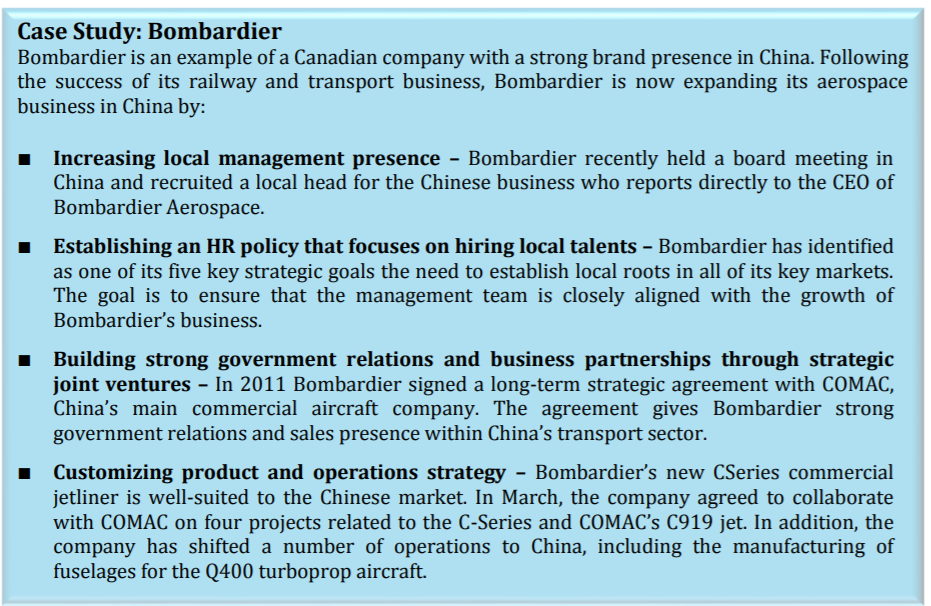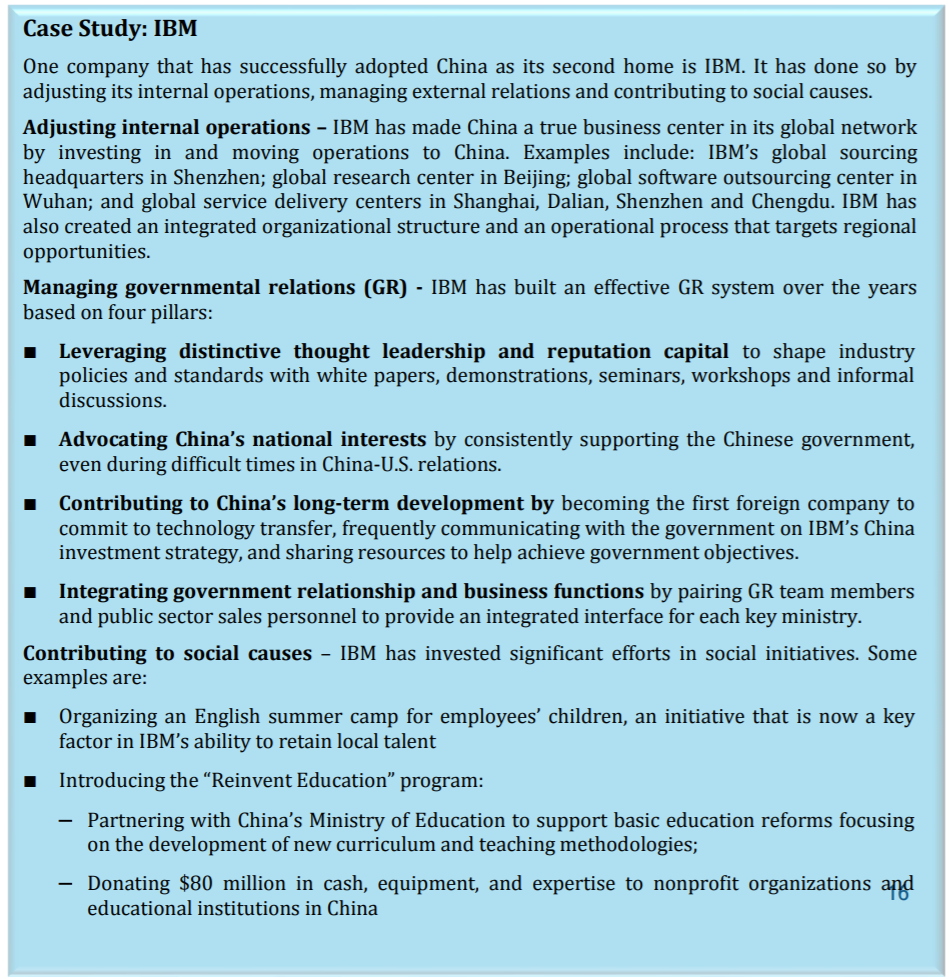A Canadian national economic strategy for Asia
Introduction
For 250 years, Canada’s strong economic links with its neighbour to the south have been a cornerstone of its growth and prosperity. While the United States will continue to be a major economic partner and critical ally for Canada, it is vital that Canada build equally strong links with Asia.
During the period from 2010 to 2025, Asia is projected to generate 33 percent of global economic growth. China, the world’s second-largest economy, is urbanizing 100 times faster than the United Kingdom did in the 19th century, and is expected to rival the United States in economic terms by 2020-2030. India, too, is urbanizing rapidly. Seven new “smart” cities are planned for the Delhi-Mumbai corridor and more than 215 million people are expected to migrate from villages to cities by 2015.
Admittedly, both India and China have experienced a sharp drop in GDP growth this year. At the same time, China’s policymakers are accelerating approvals of infrastructure investments and, in India, direct foreign investment levels are at record highs.
Asia’s growth has huge implications for governments and companies around the world, and how they react will fundamentally shape their future prospects. On the following pages, we take a closer look at the opportunities and challenges for Canadian companies doing business in China, given that China is now Canada’s second-largest trading partner. And we outline actions that Canada’s governments and business leaders could take, both separately and together, to build closer ties with Asia.
Our recommendations are not intended to be prescriptive. Rather, they are options for consideration, drawn from McKinsey’s experience in Canada and globally, as well as from best practice examples in other geographies.
In sectors ranging from agriculture to retail to consumer electronics and aviation, China is fast becoming the competitive battleground on which global winners will be determined. If a 2011 survey by the American Chamber of Commerce in China is any indication, foreign companies active there are becoming increasingly successful: they have seen their revenue, margins, and profits improve markedly. They are raising their investment levels accordingly and view the future with increasing optimism.
Admittedly, the challenges related to entering the Chinese market and flourishing there are numerous. In addition to human rights issues, companies face the need to protect intellectual property, cut through regulatory red tape, attract and retain local executive talent, cope with increasing labour costs, manage joint ventures, and navigate the intricacies of government procurement. The severity of these challenges is amplified by:
- The sector in which companies are competing. In certain sectors (e.g., consumer, retail, and some industrial sectors such as chemicals), foreign participation is encouraged and doing business is relatively straightforward. In a second cluster of sectors (e.g., energy, mining, services and automotive), participation is encouraged, but subject to some ownership restrictions. In other sectors, foreign participation is restricted and closely reviewed by the Ministry of Commerce (e.g., telecom services, financial services, and real estate/construction), or even prohibited (e.g., defense, media, and scarce basic materials). Although China recently decided to encourage private investment in some previously state-controlled sectors – including railways, finance, energy, telecommunications, education, and healthcare – it will take time before those sectors are truly open to private companies.
- The presence of large incumbent state-owned enterprises (SOEs) in the markets in which Canadian companies want to compete. SOEs, like incumbents in many countries, can often leverage large balance sheets and strong working relationships with regulators to defend their positions.
- The ability of Canadian companies to align themselves with China’s overall development agenda. In March 2011, the National People’s Congress approved its 12th Five-Year Plan, which has five pillars: increasing domestic consumption; modernizing rural communities; modernizing the industrial system; improving regional development; and improving resource efficiency. The more Canadian companies align themselves with these aims, the easier it will likely be for them to do business in China.
Considering the potential upside and the nature of the challenges, it is no longer possible for Canadian companies to succeed in China by treating it as an interesting side bet. They need to start treating China as a third home market, after Canada and the United States.
Despite the fact that Canada and Asia are linked by the Pacific Ocean, Canadian businesses lag their rivals from other OECD countries in making inroads into Asia: only half of Canada’s largest companies have operations there, whereas all of the top American companies do. Not surprisingly, many Asian business leaders see Canada primarily as a link to the United States. Canada has less brand visibility there than smaller countries such as Switzerland or the Netherlands.
Beyond China, we should not lose sight of other growth spots in Asia, specifically Southeast Asia and India. Canada and India share several fundamental characteristics: our parliamentary democracies, our Commonwealth relationship, the English language, and pluralistic societies. India is a young country too; while China’s working-age population will decrease over the coming years, India’s will increase. This presents a host of opportunities and plays to Canada’s strengths in the areas of education and infrastructure.
A Canadian National Economic Strategy for Asia
The level of strategic thinking, action, and coordination required to strengthen economic ties with Asia could prove challenging given Canada’s decentralized system of governance. However, the federal government might consider the following five potential initiatives:
1) Appoint a Minister for Asia and create a Cabinet Committee on Asia to drive and take accountability for this agenda
The Prime Minister has made Asia a priority. Although some cabinet ministers have elements of the Asia agenda in their portfolio, Asia is often just one of many issues. To signal its commitment, the Canadian government could appoint a minister responsible for the entire Asia agenda, cutting across ministries and departments. The new minister would be a key contact point for Canadian businesses, civil society, and Asian governments.
2) Establish an Asia Advisory Council
Such a Council would comprise 15 to 20 influential Asia-based politicians and business people who would meet annually with senior government officials, including the Prime Minister and Minister of Finance. The Council would be set up as a long-term body, with terms exceeding the electoral cycle, and it would be well supported to ensure initiatives are pursued and delivered. A potential model is Singapore’s International Advisory Council to the Economic Development Board.
3) Enhance diplomatic activities in Asia
Strong diplomatic ties between Canada and Asia are essential in unlocking
opportunities in Asia. Additional steps might include increasing Canada’s
consular presence in the most significant potential growth markets in Asia,
increasing the frequency and seniority of official trips to Asia, encouraging Asian government officials to visit Canada, and reviewing allocations of diplomatic budgets.
4) Strengthening cultural and educational ties
Economic ties are not built by promoting trade and investment alone; they rest on a broader network of social and cultural links. Canada currently has no mechanism or institution to provide a focal point for such efforts. The National Centre on Contemporary Asia, as proposed by the Asia Pacific Foundation of Canada, could play such a role in enhancing cultural and educational links between Canada and Asia if supported by a sufficiently ambitious mandate and budget. For example, it could:
- Promote Asian experiences (including exchanges, language immersion, co-op terms and internships) for a much larger number of Canadian secondary and post-secondary students;
- Sponsor a national Asia speaker series that would bring prominent Asian businesspeople, politicians, artists and thinkers to Canada and give them exposure in Canadian media;
- Encourage cultural and media organizations to develop more Asia content;
- Encourage more Canada-Asia links through the arts and sports
5) Partner with key sectors to help them compete successfully in Asia
In conjunction with provincial governments and, ideally, the Asia Advisory Council, the federal government could partner with a few strategic sectors and help drive the reorientation of Canada’s economy toward Asia. This could include leveraging trade missions and government visits that combine government and sector leaders to facilitate strong partnerships between the countries and help create Canadian-based global champions.
Ideally, the strategic sectors should correspond with priorities outlined in China’s 12th Five-Year Plan. Six main sectors could be considered:
- Infrastructure. Canada has some of the most admired infrastructure in the world and has developed some highly successful infrastructure models and companies. Yet Canadian companies and individuals are under-leveraging opportunities in areas such as infrastructure in Asia. For example, in the next five years alone, the Indian government projects more than US $1 trillion in infrastructure spending. It is estimated that 80 percent of the Indian infrastructure of 2030 has yet to be built.
According to a recent Economist Intelligence Unit ranking, Canada boasts three of the top 10 most liveable cities in the world. Asia’s rapid urbanization creates opportunities to share Canadian knowledge and experiences in building cities while at the same time helping to build Canadian global champions. This could be achieved by expanding the “Twin Cities” concept, having officials introduce Canadian infrastructure companies to senior officials in the largest Asian cities, and encouraging partnerships between Canadian resource companies and infrastructure firms to build and operate ports, railways, airports, and toll roads in Asian countries. - Financial services. Canada’s financial system came through the 2008 crisis in stronger shape than those of other developed economies, and its regulatory system and banks are recognized globally as role models for effective governance and risk management. Canada could leverage this to establish closer financial ties to Asia. This should be a two-way street, with Canadian banks having greater access to Asia’s growing consumer markets and Asian financial institutions, and Asian savings and capital being channeled into investments in Canada. The government could also support Asian economies in applying some financial best practices from Canada.
- Aerospace. Canada has much to offer Asia in terms of know-how, products, and services in aerospace. Bombardier is the third-largest civil aircraft manufacturer in the world – and Canada also is home to a number of successful suppliers to the industry. Given China’s determination to develop its aerospace industries, the Canadian government could have significant impact by facilitating the development of business relationships between Canadian and Chinese companies, as Europe and the United States have done with Airbus and Boeing respectively.

- Education. Increasing the number of Asian students studying in Canada has benefits beyond pure economics; it also raises Canada’s profile in Asia and provides an avenue for future Asian leaders to experience Canada firsthand. In addition to helping attract Asian students to Canada, the government could also encourage more educational partnerships, resulting in more of our universities and technical schools establishing campuses in Asia.
Universities could also do more to facilitate access for Asian students. For example, the University of Sydney, one of Australia’s top universities, announced earlier this year that it would start accepting scores based on China’s Gaokao (高考) examination for admission into an undergraduate program, as long as applicants meet the University’s English language and special entry requirements. - Tourism. By 2020, it is expected that Asia will be the source of more than 400 million tourist trips to global destinations annually. Many businesses and communities in Canada depend on tourism. The government could encourage the concerted marketing of Canadian tourist attractions in Asia, similar to the recent Australian campaign launch in China, and also help ensure that attractions are welcoming to Asian tourists.
- Natural resources. As one of the world’s largest producers and exporters of resources, and a major player in the global agri-food industry, Canada is attracting growing Asian interest. This presents growth and diversification opportunities for Canada – but also some risks.
The federal government could work with provincial governments and Canadian businesses to develop a transparent approach to managing Canada’s natural resources and its industries’ relationships with Asia. Not only would this provide flexibility and growth opportunities for Canada, it would also provide more growth and improvement opportunities for ports, infrastructure, and transportation development. Overseas investment could help bring down the cost of development, expand and modernize the nation’s resource infrastructure, and create more jobs for Canadians. It could also enable Canada to attract a hub of resource companies.
To take full advantage of this opportunity, Canada would need to proactively invest in its resource infrastructure. As the creation of such infrastructure would cross provincial lines and involve a variety of stakeholders, the federal government could play a significant role in leading and facilitating discussions. At the same time, to create a sound platform to support this approach, Canada could put in place a long-term plan for managing its resource endowment.
Such a plan would need to answer three questions:
– Under what conditions and to what degree should foreign ownership of Canadian resources be allowed?
Historically, Canada has allowed the sale of many of its natural resource companies to foreign owners. Recently, however, the federal government blocked a takeover bid for Saskatchewan’s Potash Corp. Since then, the government has announced that it will increase the threshold for reviewing foreign bids from $300 million to $1 billion. However, Canada’s policy on foreign ownership remains unclear to many. A clear position on the resources that may be sold to owners outside Canada, and under what conditions, would be optimal. Foreign ownership rules could also be designed to help create an environment that would enable globally competitive Canadian champions to emerge.
– How will Canada ensure that future generations of Canadians benefit from the non-renewable resources we are extracting today?
As many of Canada’s most important resources are non-renewable, the nation will want to take care that it is not simply spending the wealth of future generations. Interest from heritage funds set up to capture and invest resource revenues could perhaps be deployed to support Canada-Asia initiatives.
– How could Canada most responsibly manage its resources from
an environmental and social perspective?
The government should continue to work closely with natural resources businesses, environmental groups, indigenous peoples’ groups, and local communities to ensure that Canada supplies Asia’s growing resource needs in a sustainable and responsible way.
The Private Sector
In conjunction with Asia-focused public policies, Canadian companies will need to rethink their approach to doing business in Asia and their aspirations of market share, sourcing volumes, productivity, performance, and research and development activity. This also requires focusing management attention on Asia, including placing critical senior executives there.
Many leading multinationals have moved senior executives to Asia in recent months. For example, Schneider Electric, a leading French company that generates a quarter of its sales and half of its growth in Asia, announced last September it was moving its President & CEO, Executive Vice-President, Global Human Resources, and Executive Vice-President, Strategy, to Hong Kong. Schneider Electric was following in the footsteps of General Electric, Starwood, and HSBC, all of which have moved global senior executives to Asia in the past 18 months. Some Canadian enterprises are doing the same. The Canada Pension Plan Investment Board recently appointed Mark Machin as the first president of its burgeoning Asian operations.
Just as critical is to think about Asia as a market that requires the same sophisticated approaches employed elsewhere and to bring best practices to Asia in areas ranging from technology and product strategy to marketing, distribution, service, and supply chain management.
It would be naïve to suggest that Asia must be a second or third home for every company or product line, or that it will be possible in all cases to capture significant market share and scale advantages there and exploit them globally. Even when local market opportunities are limited, though, it is still possible to gain global advantages by leveraging Asia effectively.
Surprisingly, many foreign executives who ask themselves the following questions identify a significant gap between their stated intentions and Asia’s actual place on their priority lists:
Leadership presence in Asia. How many senior executives of your company are located in Asia? If they are not already located there, how much time each year do the global CEO, CFO, and other C-suite executives actually spend in Asia? When did the company last hold a board meeting there? How does this compare with the number of trips to, or board meetings in, Europe, Latin America, or North America? Is this the right balance?
Visibility into Asian operations. Do any of the company’s leaders in Asia, within either corporate functions or business units, report directly to the CEO? Are the company’s Asian operations important enough to its future that the CEO should hear about them firsthand?
Knowledge of Asian customers and suppliers. In Canada, most CEOs and business unit leaders know the CEOs of their current and potential customers and suppliers quite well. Does the CEO have similar personal relationships in Asia?
Relationships with government leaders and regulators. In Canada, top business leaders know government leaders and regulators well and
often join government advisory boards. Does the CEO have the same level of familiarity with government leaders and regulators overseeing the business in Asia? Do company leaders play any advisory roles in Asia that are similar to those played in Canada?
Product strategy. Have products been designed to meet Asian customers’ needs or are they simply imported or “de-featured” Western designs? Are price points at the same level as similar offerings from local or even foreign competitors? Is the company’s IP strategy sophisticated enough in deciding which IP to bring into Asia and what the return should be in terms of market share?
Operations strategy. Are operational performance expectations in Asia on par with those in the home market? Has the company invested as many resources or as much expertise in building and refining the company’s Asian manufacturing, distribution, supply chain, and service models? Is there enough supply chain flexibility to supply cities in the second and third tiers? Is the global supply chain agile enough to adapt to unforeseen supply disruptions given increasing global volatility?
Human resources. Is the company proactive enough in recruiting strong local talent or does it still rely primarily on expatriates? Does the company invest just as much in professional training and development programs, taught by equally qualified staff, in Asia as in Canada? Would the CEO be just as aware of a rising star in the Shenzhen office as he or she might be of someone in Canada?
Acquisition and partnership strategy. Is there a clear M&A and partnership strategy in Asia to gain economies of scale and fill in product development gaps?
In essence, Canada must become more of an Asian-facing nation. In doing so, it must move beyond its current trading patterns with Asia – exporting natural resources and importing manufactured goods – to add value to achieve mutually beneficial relationships. Australia is also resource-rich but is taking steps to avoid becoming merely a quarry nation. Canada must do the same.
We have many assets to deploy: our long history as a trading nation, a multicultural population, vibrant cities, natural resources, a successful education system, and a strong business community.

Conclusion
The world is re-balancing towards Asia, and China in particular; Canada must re-balance with it. This will not happen without strong federal government leadership. As a convener and leader, the federal government should bring together major stakeholders to define Canada’s Asia strategy and coordinate its implementation.
Companies too must take action and re-orient themselves towards Asia. It would be naïve to suggest that China must be a second home for every company or product line, or that it will be possible in all cases to capture significant market share and scale advantages there and to exploit them globally. Even where local market opportunities are limited, though, it is still possible to gain global advantages by leveraging Asia effectively. Too few executives focus on China’s long-term impact in a serious way. When they do, most conclude that China is more important than they previously imagined.
While focusing on China, we should not lose sight of other growth spots in Asia as well, particularly India and Southeast Asia. Canada enjoys strong cultural links to other Asian nations through the Commonwealth relationship and large networks of immigrants. It is essential that we leverage these advantages.
Canadian corporations are far behind the penetration curve in Asia, but there is hope. To achieve success, Canadians must move quickly, with government spearheading the effort and corporations rethinking the way they do business in Asia.











